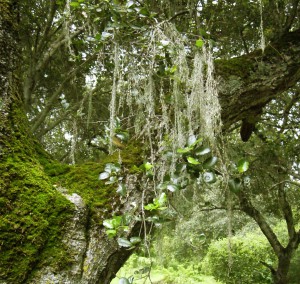Oak savannah, up until 150 years ago one of the dominant ecosystems around here in the Tri-Cities, has fascinated me ever since I first saw restored oak savannah over at Nelson Lake Marsh natural preserve. Contrary to the stereotypes I’d been fed, the prairie was not the only major ecosystem in Illinois.
The earliest settlers found almost half the State in forest, with the prairie running in great fingers between the creeks and other waterways, its surface lush with waist-high grasses and liberally bedecked with wild flowers. Here occurred the transition from the wooded lands of the East to the treeless plains of the West…. The pioneers admired the grasslands, but clung to the wooded waterways…. The waterways furnished timber for fuel and building, a convenient water supply, and protection for the settlers’ jerry-built cabins from prairie fires and windstorms. Fires invariably swept the grasslands in the late summer, when the Indians burned off the prairie to drive out game….” Illinois Descriptive and Historical Guide: Compiled and Written by the Federal Writers’ Project of the Work Projects Administration of the State of Illinois, 1939.
Where did the woodlands go?
Lumbering activities and the pioneer’s early preference for the woodland reduced the forests from their original extent, 42 per cent, to little more than 5 per cent. What is now commonly thought of as prairie is often the increment gained from the clearing of the woodlands. –Ibid.
The oak savannah is neither prairie nor forest, but a separate natural community, a transitional zone between forest and prairie. According to one definition, oak savannah has more than one tree per acre, but less than 50 per cent coverage (some authorities allow up to 80 per cent canopy coverage). The widely-spaced oaks rise out of the grassy undergrowth, giving a park-like appearance. This makes for a beautiful landscape, which feels open yet protected by trees.
How much of Illinois was savannah? According to a 1994 North American Conference on Savannas and Barrens, “No estimate of the presettlement extent of oak savanna has been developed for Illinois.” Since even modern definitions of oak savannah vary, it’s not surprising that no such estimate exists. Yet the reports of early settlers talk glowingly about the park-like settings of early Illinois, so we can be sure they knew and enjoyed oak savannah.
Funnily, the suburban landscape of downtown Geneva superficially resembles oak savannah, with its widely spaced trees and the grassy lawns. But the community of plants and animals is quite different in the suburbs than in true oak savannah, and it is a transitional zone between shopping mall and housing development, rather than a transitional zone between forest and prairie. Some early accounts say the Indians kept the oak savannah open by burning away undergrowth periodically; to shape today’s suburban savannah, humankind uses power lawnmowers and tree services.
You can see a contemporary image of oak savannah at photographer Miles Lowry’s Web site. Link The top two images are of a restored oak savannah about three miles due east of Geneva. Or if you want a technical discussion of oak savannah as an ecosystem, you can find it at the EPA’s interesting Web site on Great Lakes ecosystems. Link

